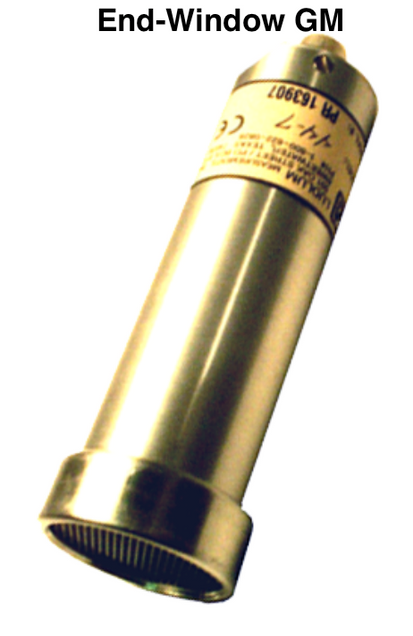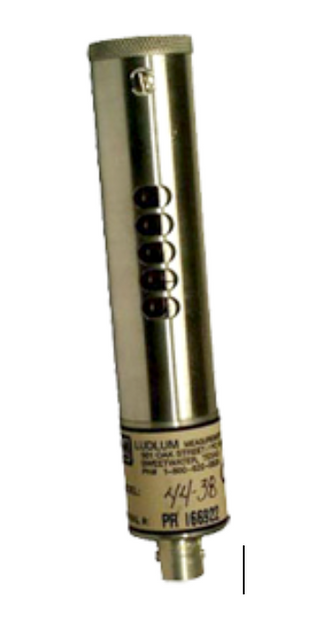RADIATION DETECTING AND COUNTING INSTRUMENTATION
ALL RADIATION DETECTION EQUIPMENT MUST BE CALIBRATED ANNUALLY
When working with radiation it is important that one have the right radiation detection equipment available to them to ensure their safety and the safety of those around them. Selecting the right equipment for your specific needs can be a daunting proposition considering the variety of radiation equipment available to end users. To that end DMPRS has put together some helpful information on the various radiation equipment available for use at BUMC/BMC. Please click on the appropriate link below to learn more about each piece of radiation detection equipment. On the bottom of the page is an instrument application guide which lists in table format what equipment is suitable for the various nuclides. If you have any questions regarding the equipment or its availability please reach out to DMPRS.
Ratemeter
The ratemeter or electronic component provides the interface for most contamination monitors. A ratemeter is an instrument that measures the counting rate of incoming electronic pulses. When connected to a radiation-detecting probe, it reports the rate at which radioactive particles are detected. An attached radiation detector provides a signal, which the ratemeter presents as a counting rate. The counting rate is generally given in either counts per minute (cpm) or counts per second (cps).

The knob on the ratemeter turns the meter on and off, and controls the scale of the readout. To find the correct cpm, multiply the reading on the gauge by the scale selected by the knob. For example, a reading of 2K on the x0.1 scale indicates a counting rate of 200 cpm. Every time you use the ratemeter, you should check the battery level to make sure it’s in the acceptable range. If the battery level falls below that range, the detector may still respond, but it won’t have enough power to respond reliably, so contamination may go undetected.
Some ratemeters, like the one shown above, display scales for both cpm and mR/hr. These scales are not interchangeable. To measure exposure rate (mR/hr), you would need a probe calibrated specifically for that purpose. Contamination surveys should be reported in cpm.
Each ratemeter should have a calibration sticker affixed to either the side or the bottom. This sticker lists the date of calibration as well as efficiencies for commonly used isotopes. An example of a calibration sticker is pictured below:

The efficiency is the fraction of emitted particles the detector picks up from a particular isotope. Using the above sticker as an example, this particular meter can detect 25% of the particles emitted by P-32, but only 6% of those emitted by C-14 and S-35. The efficiencies listed apply only to that specific probe used with that specific ratemeter. For meters with multiple probes, the numbers refer to the Geiger-Mueller detector unless otherwise specified.
Geiger-Mueller Detector
Also known as a Geiger counter, the Geiger-Mueller (GM) detector is a chamber filled with an inert gas. Ionizing radiation that interacts with either the gas or the wall of the detector will produce an electron and a positive ion. A strong electric field separates the ion pair and causes the electron to liberate other electrons, starting a chain reaction. The amplified charge is collected and registered by the instrument as a single event, producing an audible click. Because of their durability and their ability to detect low levels of radiation, GM detectors are the most common instrument used for detection of radioactive contamination.
The two main shapes of GM detectors are the pancake probe and the end-window probe (pictured below). Pancake probes will have a higher efficiency because they cover more area. Both probes must be connected to a ratemeter to be used. Each probe is calibrated to a specific ratemeter, and should not be swapped out without recalibration.


GM probes usually have a thin mica window to allow low-energy particles to enter the chamber. This window is fragile and should be treated with care. If the window is punctured, the entire probe must be replaced. Probes that have red protective caps should have these caps removed prior to conducting radiation monitoring.
GM detectors are used to detect mid- to high-energy alpha, beta, and gamma particles. They cannot, however, distinguish between different types of particles or different particle energies. Isotopes that emit low-energy gammas (e.g. I-125) or low-energy betas (e.g. H-3) cannot be detected by a Geiger counter, so other instruments must be used.
Sodium Iodide Detector
The sodium iodide (NaI) detector is a type of scintillation detector. It consists of a crystal connected to a photomultiplier tube. When a particle strikes the crystal, a photon is emitted. In the photomultiplier tube, the photon is absorbed and an electron is emitted.

This electric signal is heavily amplified by the tube and reported as a count on the ratemeter. Since the amplitude of the signal produced by a scintillation detector is proportional to the energy of the particle detected, this detector can be used to discriminate between particle energies. A ratemeter, however, is incapable of reporting signal amplitude. The detector must be connected to a different kind of meter in order to be used for this purpose.
The NaI probe is primarily used for gamma detection. The counting efficiency of the detector depends on the thickness of the crystal: thin crystals are better for low-energy gammas (like I-125), and thicker crystals are used for higher-energy gammas. Thin-crystal detectors also feature a thin end window, which should not be punctured or damaged.
Energy-Compensated GM

An energy-compensated Geiger Mueller detector consists of a GM tube encased in a metal sleeve. The metal serves as a shield to block a fraction of lower-energy gammas, preventing them from reaching the chamber.
This allows exposure rate to be directly correlated with counting rate, enabling the Geiger counter to be used as an exposure meter. Exposure rate can be used as a reasonable estimate of dose rate.
The metal sleeve will block alphas and most betas, so many probes incorporate holes in the sleeve that can be uncovered when low-energy gammas or betas are known to be present. The energy-compensated GM is usually inappropriate for a laboratory setting, as a significant amount of activity must be present to give a reliable reading. This detector is common in clinical areas where exposure rate is a concern, although a regular GM or NaI detector should still be used to locate contamination. Some energy-compensated detectors are completely contained inside a ratemeter to prevent damage and increase ease of use.
Ionization Chamber
 Like the Geiger counter, the ionization (ion) chamber is a gas-based detector, but it is operated at a much lower voltage. At this voltage, no electron chain reaction takes place. Single events therefore cannot be detected, but the overall accumulation of charge in the air can be measured. Higher-energy particles create more ion pairs, so the signal is proportional to exposure rate, which is proportional to dose rate.
Like the Geiger counter, the ionization (ion) chamber is a gas-based detector, but it is operated at a much lower voltage. At this voltage, no electron chain reaction takes place. Single events therefore cannot be detected, but the overall accumulation of charge in the air can be measured. Higher-energy particles create more ion pairs, so the signal is proportional to exposure rate, which is proportional to dose rate.
Ion chambers can function using regular air (in open or closed configurations) or a pressurized gas. This flexibility allows them to be constructed in many different shapes and used for many different purposes. Ion chambers are capable of reliably measuring much higher exposure rates than energy-compensated GMs, but they cost significantly more and are more fragile. Ion chambers are primarily used to measure gamma exposure, but some detectors come equipped with thin beta windows that can be uncovered to measure beta exposure.
Liquid Scintillation Counter
The liquid scintillation counter (LSC) is another type of scintillation detector. In this case, the scintillating medium (called the fluor) is contained in a fluid in which the sample is dissolved or submerged. (Cerenkov counting does not utilize scintillation fluid instead water is used to count high energy betas) Particles emitted from the sample excite molecules in the fluid, which emit photons in the UV range. These photons excite the fluor molecules, which in turn emit photons in the visible spectrum. The visible photons are converted to an electrical signal and amplified in a photomultiplier tube. The number of photons produced is proportional to the particle energy, so the LSC can be used to discriminate between radiation events of different energies.
The LSC is especially useful for detecting low-energy beta particles, which can be difficult to detect using other methods. Tritium (H-3), for example, can only be detected using an LSC. Alphas can also be counted in the LSC, but energy transmission to the fluor is not as efficient as with betas, so the signal will show up in a much lower energy channel than would be expected. Gammas can be detected in the LSC as well.
There are some drawbacks to using an LSC as opposed to a portable detector. Only removable contamination can be detected, and counting results are not immediately accessible, so careful notes must be taken when conducting a survey. Nevertheless, wipe tests using an LSC are still the best option for laboratories working with low-energy beta emitters.
Instrument Application Guide
